Ford conducts intramural Car-SUV duel
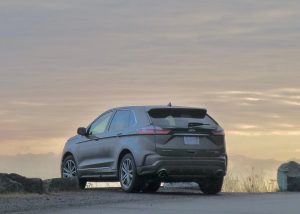
Newest Edge takes 2019 center stage for Ford, which is moving toward the Mustang vs. all-truck-SUV lineup.
If it’s time for a new family car, and your budget is sorted out, and now comes the ultimate decision. Do you buy the car of your dreams, or do you give in to the overwhelming trendiness but expansive versatility of a sports-utility vehicle?
If you happen to favor Ford Motor Company, you can face the decision in the same showroom:Like a major prize-fight, we have, in one corner, the flashy Mustang GT, with its swept-back roofline and spectacular color, and in that corner, we have the all-newly redesigned Edge midsize SUV. Both have their proper measures of appeal.
It might depend on your family. With the Edge you can haul the family anywhere, vacation trips, hockey practices, or to the shopping center, with all the comforts of home. With the Mustang GT, you will attract attention every time you start the engine, or cruise the neighborhood, resembling a slightly aging hot-rodder.
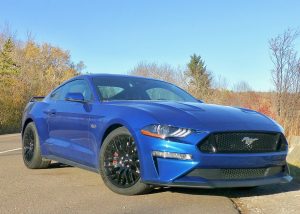
The Mustang GT Coupe Premium with 460 horsepower and precise handling is the best example of Ford’s car offerings.
There are benefits to both extremes, one of which lures your logical, family-oriented self, and the other which genuinely stirs all those primal juices of emotion. Pragmatic or passionate? You get to choose.
Maybe we really have gone over the edge in our society — I mean in car selection, not in politics — and maybe we really do prefer trucks and SUVs to cars. Or maybe we don’t, but are victims of auto manufacturers who are eager to build us SUVs and trucks rather than cars because they can push them out the dealership doors for three or four times the profit.
Whatever, we keep hurtling down that highway to changing the family car for the family truckster, and a perfect example of the whole societal shift is Ford Motor Company.
Ford can be excused for being truck-crazy, because it builds the F-150, which has become the most popular vehicle in the country, in fact the world, and continues to dominate the hotly competitive pickup segment.
Where it gets curious is that Ford executives announced several months ago that it will stop building several popular models of cars, and devote more attention to trucks and SUVs. The first word was that Ford would eliminate all but the Mustang and the compact Focus, then we heard only the Mustang will continue, in Ford’s drive to truck nirvana.
We know the Mustang is alive and well as it continues its amazing story of survival that started with its stunning introduction in 1964. The new one came out all new for 2018, so we don’t expect anything major when the 2019 model arrives. Just as well. It’s hard to imagine many improvements that could be made on the 2018 — especially the Lightning Blue GT model that arrived just before winter’s first blast.
Good thing, because with its 5.0-liter, dual-overhead-camshaft V8 spewing 460 horsepower and 420 foot-pounds of torque to the huge rear tires, your chances of avoiding slippage on a slippery roadway are slim, taking the heart-in-your-throat quotient sky-high in an instant. The 10-speed automatic can harness all that power, but only with judicious use of the gas pedal.
The Mustang GT Coupe Premium came in at $52,765 in aptly named Lightning Blue Metallic, and that included $10,000 in optional equipment to enhance performance, handling, sound enjoyment, and connectivity aids with the latest SYNC system. Ford also makes upgrades such as the Bullitt replica of the old Steve McQueen movie that started the craze toward wild car chases in Hollywood, and the Shelby GT.
But the basic Mustang GT is just right for my tastes, and I think from the standpoint of style, steering and handling tightness, and power, this is the best Mustang in over 60 years of trying.
When it was picked up, the Chicago new-car delivery agency dropped off a new Edge, the loaded-up Platinum model.
Hopping out of one and into the other made for an interesting comparison, because we already know the front-engine, rear-drive Mustang will remain the icon of Ford’s car fleet now and in the future, and the Edge comes down right smack in the middle of Ford’s SUV herd, which includes the Expedition at the top, then the Explorer above the Edge, and the more compact Escape and the subcompact EcoSport below the Edge. There are others, such as the squarish Flex and the coming rebirth of the Bronco.
The Edge wears a stunning new look, which can fool most of the people most of the time, but is really a partial renovation with only the newly restyled front and nicely tapered rear and a redone interior carrying the model into its latest iteration. It wasn’t bad as it was, of course, and the new styling assures the Edge of staying hot.
The test Edge in Stone Gray Metallic had the 2.0-liter Ford Ecoboost 4-cylinder engine, with a twin-scroll turbocharger helping the transition from low RPMs to higher revs, and the Ecoboost scheme delivering 250 horsepower and 275 foot-pounds of torque. That’s a lot, out of a 2.0, and it is sufficient power for a midsize SUV, although if you want more, the ST model offers a larger 2.7-V6 Ecoboost. The 8-speed automatic handled it all well. I was, however, disappointed by the fuel economy, because we registered 24 mpg in mostly city-rural driving, and there are a number of competitors that can reach 30.
Furthermore, the test Edge came with Titanium trim materials, but with front-wheel drive. No all-wheel drive, unless you opt up, which makes sense, I guess, but makes the meager fuel economy of th FWD model more disappointing.
I thought the leather seats were luxurious, and the switch work was well done with the latest SYNC plan. The rear seat is also nicely appointed, with a big sunroof overhead and electrical plug-ins, including a household electric receptacle, in between the rear seats.
One more criticism is the tendency to follow the norm and put bigger and bigger tires and wheels on SUVs. The test Edge had 20-inch wheels and it felt abnormally tall on those wheels, especially with only front-wheel drive supressing any urge for even mile off-road ventures. It handled well, but I couldn’t escape the idea that 18-inch wheels would provide a lower stance and the feeling of more stability and better handling.
At about $45,000 — the sticker diplomatically avoided providing the price — the Edge had pre-collision warning and assist, rear camera, lane-keeping assist, and LED headlights, with hands-free tailgate and rain-sensing wipers and blind-spot assist.
If you want big-time handling, of course, the Mustang is waiting in the wings. New Car Picks reported on the Mustang GT a short while ago, and that one was fun, with a 6-speed stick. The second trial is the very neat blue with all the hot-rod equipment you might want, and the same 5.0-liter V8 with 450 horsepower shifting smoothly among the 10-speed automatic’s impulses.
With the automatic, you can go to a sportier mode that makes for noisier and sportier running, with firmer suspension and heightened shift points, eliminating a couple overdrive gears to give you more punch at any rev range. The sport setting adds a thrill to the exhaust sound, as well. You can get over 20 miles per gallon, and even up to the mid-20s, but you’d want to resist the urge to hammer the gas pedal to do it.
Comfortable bucket seats, trimmed in leather, and adaptive cruise control, cross traffic alert in the rear, a high-performance package that includes an upgraded audio, LED headlights, and a neat ambient lighting trick that displays a galloping mustang on the street or parking place you’ve chosen, just below the door. A lot of slick electronic choices from the changeable instrument panel add to driving enjoyment.
There is, however, precious little room in the rear seat, so the Mustang would work if you have no small children, or if your kids are small enough to bring their legs with them.
The Mustang with touchscreen navigation, costs a bit more than the Edge, but you are choosing between a great disparity in motoring enjoyment. The Edge handles and performs pretty well, but without all-wheel drive or impressive fuel economy; the Mustang handles like a race car on the street, and is built for fun, with potent acceleration and handling, but also without great fuel economy or foul-weather traction.
Both vehicles strike a pleasing stance, with the Edge sporting its new sheet metal, while the Mustang is obviously equipped to fight for its position in the product line as the only car soon to be left in the corporate jungle of SUVs.


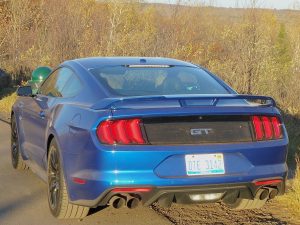
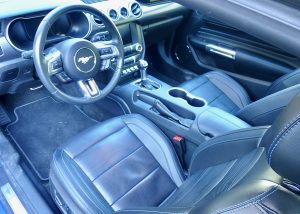
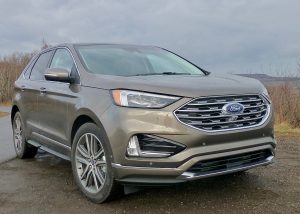
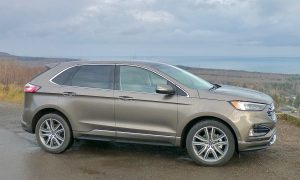
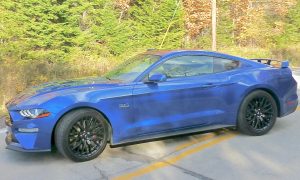
 John Gilbert is a lifetime Minnesotan and career journalist, specializing in cars and sports during and since spending 30 years at the Minneapolis Tribune, now the Star Tribune. More recently, he has continued translating the high-tech world of autos and sharing his passionate insights as a freelance writer/photographer/broadcaster. A member of the prestigious North American Car and Truck of the Year jury since 1993. John can be heard Monday-Friday from 9-11am on 610 KDAL(www.kdal610.com) on the "John Gilbert Show," and writes a column in the Duluth Reader.
John Gilbert is a lifetime Minnesotan and career journalist, specializing in cars and sports during and since spending 30 years at the Minneapolis Tribune, now the Star Tribune. More recently, he has continued translating the high-tech world of autos and sharing his passionate insights as a freelance writer/photographer/broadcaster. A member of the prestigious North American Car and Truck of the Year jury since 1993. John can be heard Monday-Friday from 9-11am on 610 KDAL(www.kdal610.com) on the "John Gilbert Show," and writes a column in the Duluth Reader.